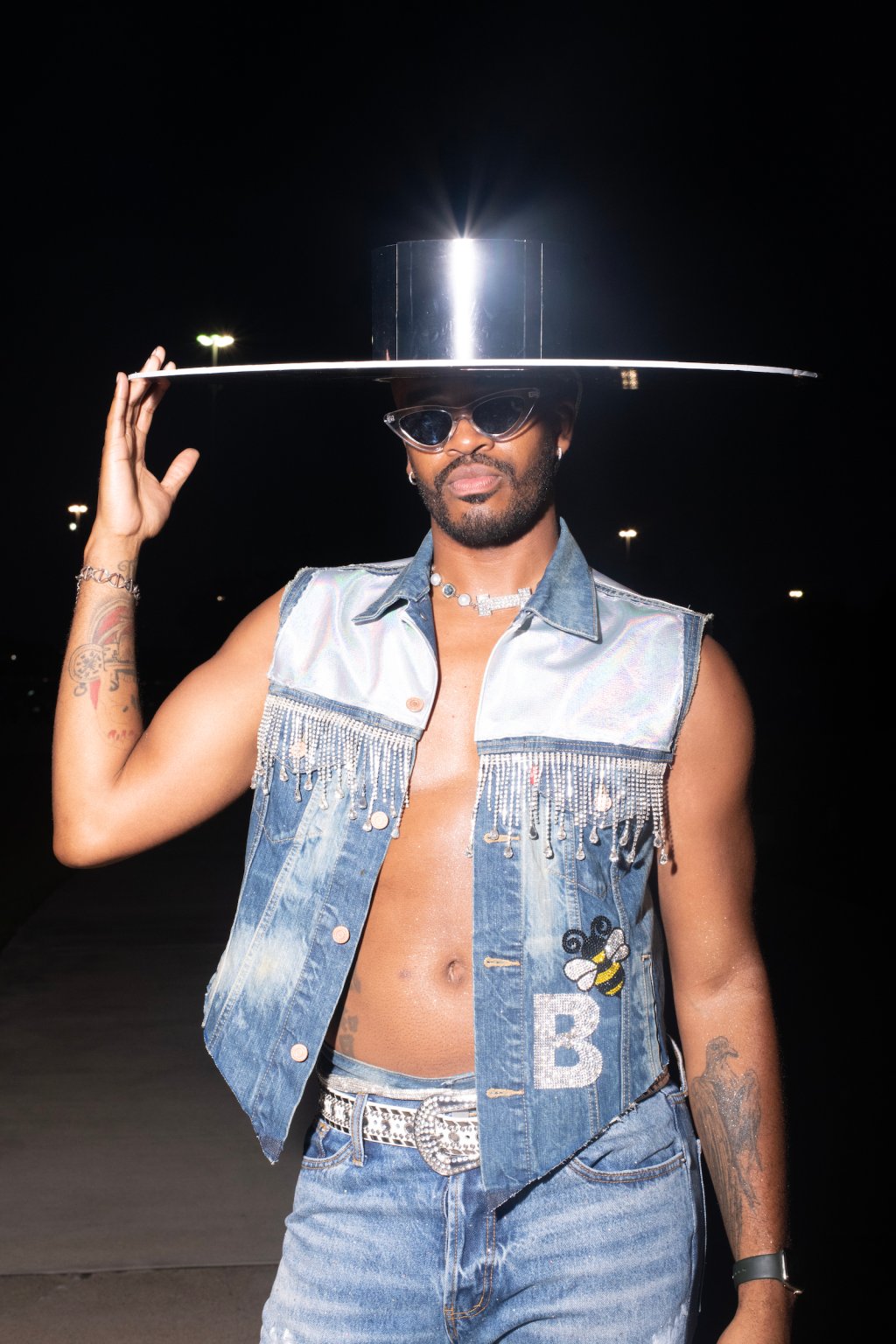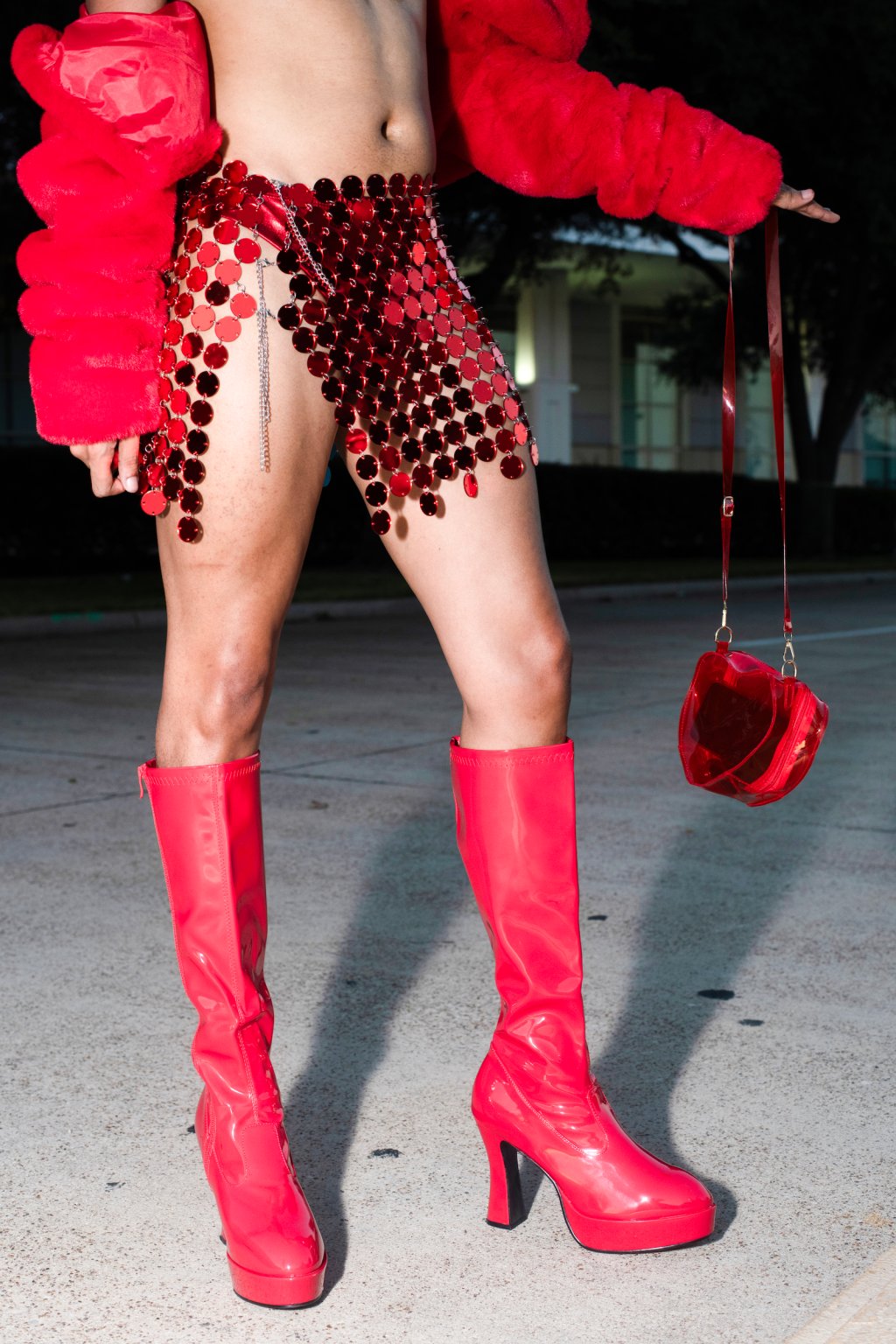On Sept. 23 and 24, Houston was host to Beyoncé’s brilliance. The city took note: Harris County was dubbed, for several days, Bey County. Traffic across the inner loop’s interlocking roads felt more insufferable than usual. Both performances sold out, cries for last-minute tickets proliferated social media, and, arriving at NRG Park on either night—past the highway, over the hill, across the bridge, and into the 72,220-seat stadium—felt a lot like floating on electricity, or the precipice of a foundational shift.
Beyoncé’s assignment for previous cities had been simple: wear silver. Houstonians also obliged. Ascending the venue’s walkway, a group of Black women with glowing centaur horns and heels glided past my boyfriend and me. A caravan of bears dressed in frilly crop-tops and boyshorts with knee-high boots followed them. The weekend saw legions of silver ballcaps, silver cowboy boots, silver capes, silver earrings, silver chains, silver gloves, silver thongs, silver facemasks, silver bodysuits, silver shades, silver track pants, silver piercings, and silver jackets glowing from the hall’s highest concessions and back down to the floor seats. My own aesthetic was something like femme biker cub, alongside a silver cowboy hat—an outfit I passed at least nine variations of on the way to our seats.
Both evenings, Beyoncé’s first address, entering a stadium that hit an astounding decibel, and an electricity she’d conjured entirely on her own, was: “Houston, Texas, I love you.” She called this series of performances, a global tour that began in Stockholm this May, her “gratitude tour.” Then, she proceeded to grace us. Beyoncé began with the operatic, before dipping coolly into a deep trill. Beyoncé rolled from a crisp set of notes into a growl and back, before descending again, only to ascend seemingly six more octaves a second later. Beyoncé vogued with a series of robot arms, cascading directly into a croon. Beyoncé vogued with a team of glowing dancers, as they snapped fans and duck-walked and clicked heels alongside her (Girl, whispered one of the bears beside us). Beyoncé rapped, as brash and present as your favorite rapper’s favorite rapper. Beyoncé rode a metallic tank on stage (Girl, exhorted one of the women, a New Orleanian, in front of us), swinging from a structure atop it, grinding and cheering and jeering and carrying.
More From TIME
Read More: 100 Women of the Year: Beyoncé
Numerous outfit changes unspooled before us. Between each section of the set, house music blasted beside kaleidoscopic visuals. In the midst of its immaculateness, each evening’s rollout achieved, and then eclipsed, what might be the highest bar for a performance: a solid night out at the club, dancing with your friends. And any single one of these components would’ve made an incredible show. But this was simply beyond what could or should be expected or thought of from an actual individual—and, as the performance continued, each night, there was no peak, really. Beyoncé’s performance simply escalated, ascending a mountain of precision with no visible climax, and then it ended.
Mid-way through her set, as Beyoncé rolled into “Church Girl,” a chorus opened behind her. My sequin-clad neighbors sighed, blushing. A lady in a silver-spiked vest beside me squeezed my elbow. She said, “We’re here,” and I concurred, and then she began to cry.


In many ways, the Renaissance tour, which is scheduled to end on Oct. 1 in Kansas City, is an extension of Beyoncé’s overarching ambition: over nearly three decades, and nine solo concert tours, she has constantly reinvented herself. Her sound, her presentation, and her audience’s expectations for what a performer can, or should, be or do have risen alongside her. Across more than 50 shows internationally, she has managed to eclipse seemingly every expectation but her own.
And Beyoncé’s Renaissance album itself further underlined her prowess’s scope: the record is a celebration, among other things, of the Black origins of disco and house music, Black ballroom, vogue, drag, and the infinitude of crevices encapsulating any particular nook or cranny of queer culture. Each track announces itself. They are physical and emotional. The record champions Black queer artists, ceding space and attention to their works from song to song. And upon a first, third, or 30th listen, it’s hardly difficult to allow each track to progress like a breezy, singular set unfurling from the hands of its deeply meticulous curator. Much of the record’s genius resides in how its communities are magnified, accentuated, and given the floor to dance.
Read More: 6 Revelations From Beyoncé's Album Renaissance
But Renaissance’s immersion, and embrace of the queerness permeating its beats, gives the record a very particular context: as a result, the life that it’s lived—and the life it will continue to live—has taken very different forms from her previous projects. I’ve heard “Thique” at queer orgies in Oakland. I’ve heard “Cozy” between cocktails at brunch after brunch in Los Angeles. It seems like every queer I know worked their way through some sort of “Alien Superstar” Sailor Moon mashup. Earlier this year, I listened to “Virgo’s Groove” in the smoking room of a sauna in Osaka, several nights before it shut its door forever, and every man beside me mumbled the chorus.
My own first encounter with Beyoncé live is so commonplace in Houston as to be anecdotal lore for anyone who grew up in the city: I saw her for the first time at the Houston Livestock Show and Rodeo in 2004. I saw her again when she returned in 2007. Despite an environment largely built for the apex of masculinity—inundated with cowboys donning bravado and brashness—her performances felt like a bright, bright light. She was everything, and then some. Since then, I’ve seen her in other cities, in her other iterations, sets, and modes, but these initial performances had been, for me, cemented into my conception of her—at least until the Renaissance tour.
Lately, I’ve spent more time outside of Houston than in, but it wasn’t negotiable that I would be in town for this record’s performance at NRG. It simply had to happen. I suspect many of the show’s queer local attendees felt the same. And while Beyoncé’s ascension to the peak of performance is hardly inevitable, sometimes, watching her on stage, it all felt like a natural crescendo: that one of the best performers and musicians in the world is a Black woman from Houston could only be surprising to someone outside of Houston.
On Sunday evening, as Beyoncé rolled into “Diva,” she addressed the crowd: “You know you’re responsible for your own happiness? Your own joy?”
And later: “I want this to be a safe space. I want you to let loose.”
And later: “I want you to remember who you came here with, what you wore. Remember this night.”
Quips like these were peppered throughout each evening. This, too, felt deeply constructed: Beyoncé’s performances felt both entirely interstellar and deeply, deeply local. She thanked attendees at every level, acknowledging those in the highest seats first, nodding to the sacrifices that many folks in the room likely made to see her that evening. Houston, she noted, would be a place that she’d carry wherever she went. When she said it, you really f-cking believed her. And as she worked at what felt like the pinnacle of human performance, care was taken between songs to remind the crowd to be present for the concert, sure, but also for themselves.
But what may have been the most remarkable component of the show, for me, lay within its final moments: as the performers launched into “Pure/Honey,” the set’s penultimate track, the stage was ceded to the dancers to vogue in a tight, bright circle. Everyone who’d stood with Beyoncé throughout the show, in some capacity, was given a moment. Which was a deafening punctuation mark on a deeply deliberate thesis that the performers, crews, assistants, and architects had spent nearly three hours constructing: the event was made possible by queerness—and the culture of Black queers across the decades, specifically. Seeing this in a room of tens of thousands, as a disco ball passed overhead, felt stunning to the point of elation.
Because this fantasia, for many folks watching in Houston, dissipated immediately after the set was over. Texas is one of the most hostile states in the country for queer people. In the past year, more than 100 bills targeting LGTBQ+ communities were introduced in the Texas legislature, making up over 20% of anti-queer legislation that has emerged in state governing bodies across the U.S. Gender-affirming care is no longer accessible for trans minors in Texas; the state has joined others in creating many more refugees looking to leave its borders. An anti-drag bill has just been defeated in the courts. Book bannings are routine. LGBTQ+ affirming centers on public universities have been eliminated, and Texas continually attempts to advance its own iteration of a “Don’t Say Gay” bill. There are few areas of public life in the state where its government hasn’t at least attempted to eradicate its queerness from visibility.
And maybe, this, too, is further evidence of Beyoncé’s excellence: for a few hours, we all were privy to something better. A better way of being. I’ve seen and experienced things in my life that I never would have thought I’d see, but I simply could not have imagined standing in the same stadium I first saw Beyoncé—dressed in leather and mesh, alongside queers from across the community very openly enjoying themselves—watching the culture not only be celebrated but also accentuated. Much talk is made of Beyoncé’s otherworldliness—and her very visible labor allows this—but what’s more interesting, and extraordinary, is that she is entirely human. Calling her Houston performances perfect would, in some ways, belie the many things they achieved. In that stadium, she expanded possibility—an even higher bar, more elusive and foundation-shifting.
Leaving the show both evenings, Houston’s gayborhood, Montrose, felt energetic in a way that it simply hadn’t in some time. Money has invaded the neighborhood in the last decade, sealing many of each block’s vectors for queer visibility into neat lines. But, on these nights, the streets were packed. The clubs were packed. The bear bar and the kink bar and the dance bar and up-and-coming-bar and the druggy bar and the party bar vibrated with energy, until security told us all to go home, shepherding folks onto the sidewalk—and then we stood outside, buzzing still.
Walking back to my car with my guy Sunday evening, groups of folks making their way back to their own homes strolled underneath the neighborhood’s patchy shrubs. Some chewed taco truck fare. Some still glowed from the evening’s performance, literally golden. Others were headed to afterparties downtown, and elsewhere throughout the city, until well into the morning. But, eventually, we all split off, and another pair of guys walking beside us shared our silence for a few blocks, before we eventually turned to each other, instinctively, and smiled, and said to get home safe. This, too, felt like an extension of the moment, like the show will continue enveloping us, even still.
More Must-Reads From TIME
- The 100 Most Influential People of 2024
- Coco Gauff Is Playing for Herself Now
- Scenes From Pro-Palestinian Encampments Across U.S. Universities
- 6 Compliments That Land Every Time
- If You're Dating Right Now , You're Brave: Column
- The AI That Could Heal a Divided Internet
- Fallout Is a Brilliant Model for the Future of Video Game Adaptations
- Want Weekly Recs on What to Watch, Read, and More? Sign Up for Worth Your Time
Contact us at letters@time.com
